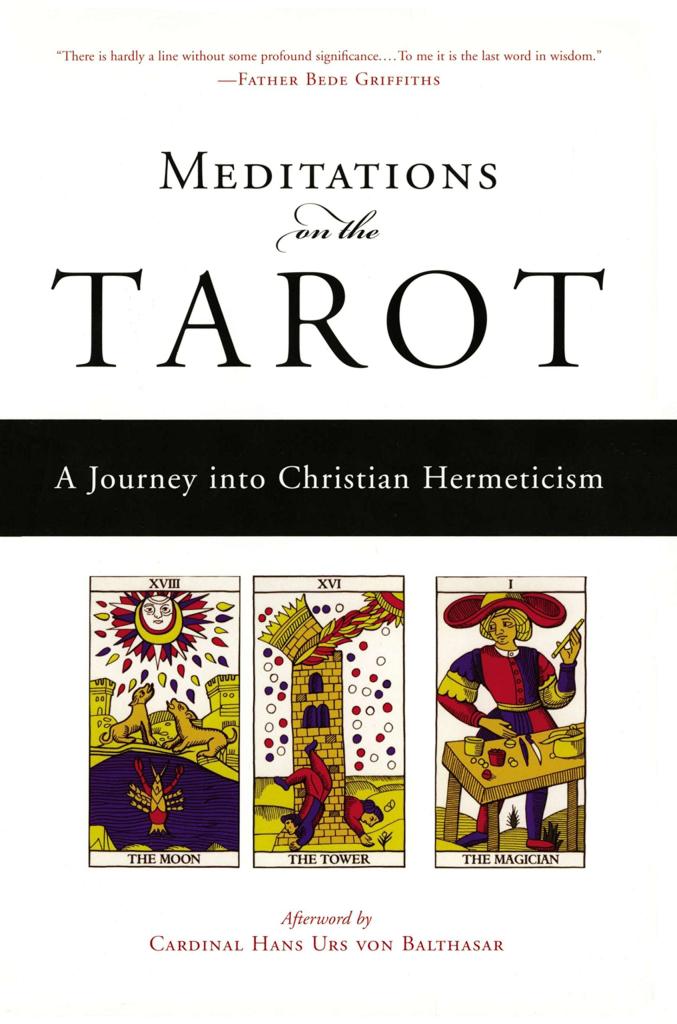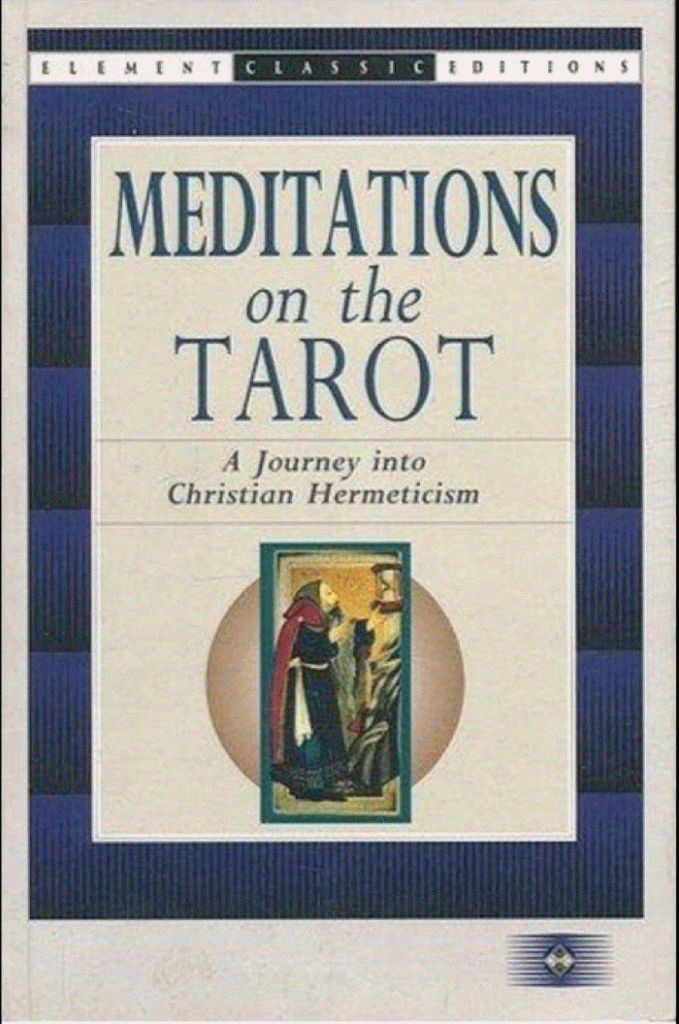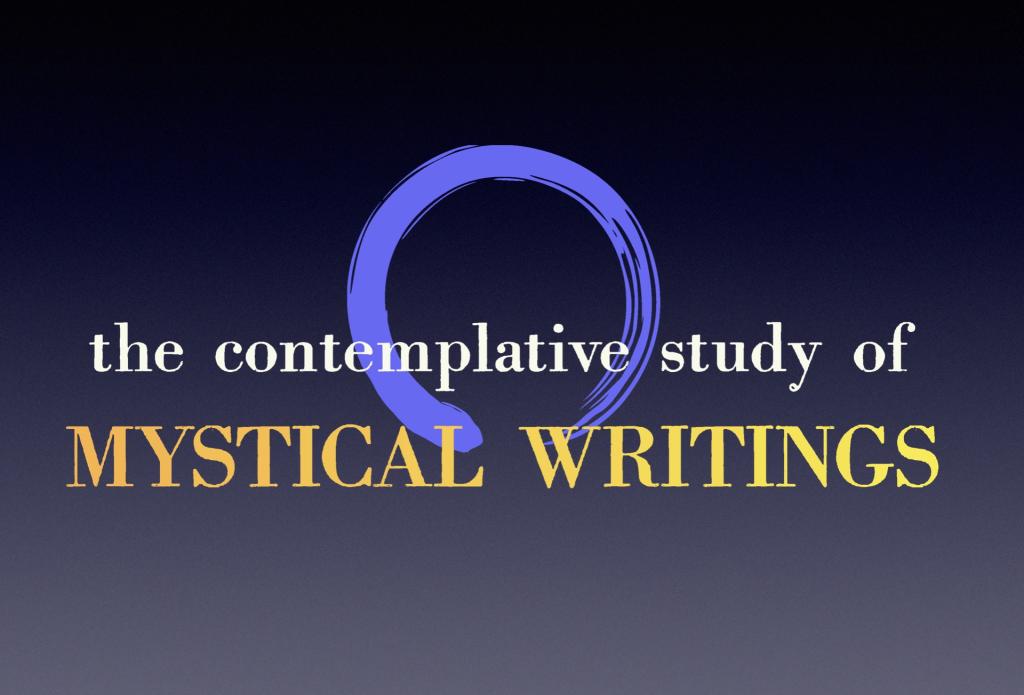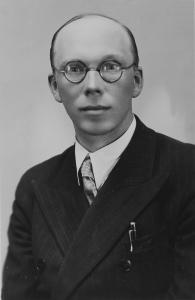Tarot metaphysics.
===
Meditations on the Tarot: A Journey into Christian Hermeticism Kindle Edition
by Anonymous (Author), Robert Powell (Translator), & 1 more Format: Kindle Edition
4.7 out of 5 stars 355 ratings
Part of: Element Classic (3 books)
See all formats and editions
Hardcover
from $29.74
5 Used from $29.74
4 New from $38.49
Paperback
from $12.50
30 Used from $12.50
22 New from $15.26
Now in a fully corrected edition, one of the true spiritual classics of the twentieth century.
Published for the first time with an index and Cardinal Hans Urs von Balthasar’s afterword, this new English publication of Meditations on the Tarot is the landmark edition of one of the most important works of esoteric Christianity.
Written anonymously and published posthumously, as was the author’s wish, the intention of this work is for the reader to find a relationship with the author in the spiritual dimensions of existence. The author wanted not to be thought of as a personality who lived from 1900 to 1973, but as a friend who is communicating with us from beyond the boundaries of ordinary life.
Using the 22 major arcana of the tarot deck as a means to explore some of humanity’s most penetrating spiritual questions, Meditations on the Tarot has attracted an unprecedented range of praise from across the spiritual spectrum.
Read less
Print length
681 pages
Language
English
Next page
Books In This Series (3 Books)
Element Classic
Kindle Edition
The Last Barrier: A Sufi Journey (Element Classic Editions)
Reshad Feild
4.9 out of 5 stars (9)
Kindle Edition
Meditations on the Tarot: A Journey into Christian Hermeticism
4.7 out of 5 stars (355)
Kindle Edition
Lost Christianity: A Journey of Rediscovery to the Center of Christian Experience (Element Classic)
Jacob Needleman
4.7 out of 5 stars (5)
Kindle Edition
Customers who viewed this item also viewedPage 1 of 11Page 1 of 11
Previous page
Signs & Wonders - Tarot Cards for Christians
Signs & Wonders - Tarot Cards for Christians
Pastor Ahyh
4.5 out of 5 stars 26
Kindle Edition
1 offer from $5.99
The Marseille Tarot Revealed: A Complete Guide to Symbolism, Meanings & Methods
The Marseille Tarot Revealed: A Complete Guide to Symbolism, Meanings & Methods
Yoav Ben-Dov
4.8 out of 5 stars 200
Kindle Edition
1 offer from $18.99
Christ and Sophia: Anthroposophic Meditations on the Old Testament, New Testament, and Apocalypse
Christ and Sophia: Anthroposophic Meditations on the Old Testament,…
Valentin Tomberg
4.7 out of 5 stars 21
Kindle Edition
1 offer from $7.99
Tarot and the Archetypal Journey: The Jungian Path from Darkness to Light
Tarot and the Archetypal Journey: The Jungian Path from Darkness to…
Sallie Nichols
4.7 out of 5 stars 177
Kindle Edition
1 offer from $15.31
The Way of Tarot: The Spiritual Teacher in the Cards
The Way of Tarot: The Spiritual Teacher in the Cards
Alejandro Jodorowsky
4.8 out of 5 stars 347
Kindle Edition
1 offer from $16.99
Next page
Editorial Reviews
Review
“It is without doubt the most extraordinary work I have ever read. It has tremendous spiritual depth and insight.” —Trappist abbot Basil Pennington, OCSO
“It is simply astonishing. I have never read such a comprehensive account of the ‘perennial philosophy.’ ” —Father Bede Griffiths
“This book, in my view, is the greatest contribution to date toward the rediscovery and renewal of the Christian contemplative tradition of the Fathers of the Church and the High Middle Ages.”—Trappist abbot Thomas Keating, OCSO
“Meditations on the Tarot has become instrumental in my thinking….The writer – who calls himself ‘Unknown Friend’ – seems to be speaking to me directly, with endless wisdom and inspiration.” —Gerald Epstein, M.D., author of Healing Visualizations
“The most beautiful and instructive book of the twentieth century concerning Western esotericism.”—Antoine Faivre, professor for the History of Esoteric and Mystical Streams in Modern Europe, the Sorbonne University
“The book begs not only to be studied cover to cover, but also to be savored, meditated upon and assimilated into one’s life.” —Richard W. Kropf, National Catholic Reporter
--This text refers to an out of print or unavailable edition of this title.
About the Author
Written anonymously and published posthumously in 1980 at the wishes of its author, Meditations on the Tarot has been translated from the original French by writer and esotericist Robert Powell, who lives in Germany. Widely considered one of the greatest Catholic theologians of the twentieth century, the Swiss-born Hans Urs von Balthasar, who wrote the afterword in this new edition, was nominated by Pope John Paul II as a cardinal in 1988, and died in June of that year, two days before his inauguration.
--This text refers to an out of print or unavailable edition of this title.
Product details
ASIN : B00B1FG9PI
Publisher : TarcherPerigee (August 25, 2005)
Publication date : August 25, 2005
Language : English
File size : 4694 KB
Text-to-Speech : Enabled
Screen Reader : Supported
Enhanced typesetting : Enabled
X-Ray : Enabled
Word Wise : Enabled
Print length : 681 pages
Lending : Not Enabled
Best Sellers Rank: #153,548 in Kindle Store (See Top 100 in Kindle Store)
#47 in New Age Divination with Tarot
#69 in Spiritual Meditations (Kindle Store)
#80 in Mysticism (Kindle Store)
Customer Reviews: 4.7 out of 5 stars 355 ratings
Videos
Help others learn more about this product by uploading a video!
Upload video
Sponsored
How would you rate your experience shopping for books on Amazon today?
Very poor Neutral Great
Customer reviews
4.7 out of 5 stars
4.7 out of 5
355 global ratings
5 star
82%
4 star
8%
3 star
6%
2 star
2%
1 star
1%
How are ratings calculated?
Review this product
Share your thoughts with other customers
Write a customer review
Sponsored
Read reviews that mention
unknown friend valentin tomberg meditations on the tarot anonymous author dear unknown beyond the grave ever read eliphas levi hermetic tradition christian hermeticism years ago addressed to the unknown hans urs von balthasar tarot cards back cover highly recommended book i have ever published anonymously couple of years
Top reviews
Top reviews
Top reviews from the United States
Karl3993
5.0 out of 5 stars One of the very best books of the 20th Century.
Reviewed in the United States on July 13, 2018
Verified Purchase
If you have an interest in esoteric Christianity, or an interest in plumbing the depths of what the Apostle Paul called "the secret and hidden wisdom of God" (1Corinthians 2) then this book will be of great interest to you. For many reasons it isn't an easy read. First, you have to be capable of independent thought. Second, you must be open to seeing the world around you in terms that are (at least) somewhat different, maybe very different from those with which you have become accustomed. And finally, for the modern Christian this book is especially challenging because it approaches Christian spirituality from the point-of- view of the Major Arcana of the Tarot. At the outset many a Christian will shrink from this approach as one would surely shrink from a dark and malevolent superstition. However, this would be an error. The Major Arcana provide a framework within which the author discusses many aspects of (again paraphrasing Paul from 1Timothy) "the profound mysteries of our religion." If you are interested in an exploration of these mysteries that is erudite, discerning, and filled with penetrating insight then this may very well be a book for you. In my view this book is one of the few that is worthy to be placed on the bookshelf next to the Holy Scriptures. A book of this kind can be a lifetime study.
One of the very best books of the 20th Century.
Read less
114 people found this helpful
Helpful
Report abuse
S. Buday
5.0 out of 5 stars This is an excellent book for meditation on the major arcana of the ...
Reviewed in the United States on July 31, 2018
Verified Purchase
This is an excellent book for meditation on the major arcana of the tarot through the lens of the Hermetic tradition in Christianity (yes, there is such a thing). This book is not for the tarot novice and it will not explain how to interpret tarot. If this is your aim, there are countless other books that can help you. Hermetic philosophy was strongly influential in Europe during the early years of the Renaissance due to the discovery and translations of Hermetic manuscripts. The Church began to see it as heretical because it challenged the notion of "creatio ex nihilo" (creation out of nothing) and embraced the idea of "creatio ex Deo" (creation out of God). This meant that all things in the universe where made directly from God's own being rather than the still strong held belief that God is completely separate and other from God's creation. Despite this heresy (and a few others), Hermeticism survived in secret throughout the Catholic Church (sometimes even at the rank of the Pope), hence why we have this book today. The meditations in the book show a great understanding of tarot, Hermeticism and Catholic faith, history and mysticism.
46 people found this helpful
Helpful
Report abuse
Readsalot
3.0 out of 5 stars Meditations on the Tarot by Cardinal Balthasar.
Reviewed in the United States on May 28, 2020
Verified Purchase
Sorry, but a far, FAR better book, more profound, enlightening, by the founder of the once closed international Tarot Organization 'Builders Of The Adytum " (BOTA) by Paul Foster Case is designed to lead reader to Cosmic Consciousness. The book ; Tarot Card Meanings -Fundamentals by P F Case- the book was once only found on their website, but now available on Amason. It is half the size of this book Meditations on Tarot, but considerably more insightful & it a much higher class of it's own. So I cannot give more than an average 2 star to Cardinal Balthasar's book, it simply isn't even close. The P F Case Book is filled with deeper spiritual meanings and symbols.
18 people found this helpful
Helpful
Report abuse
amazon customer
5.0 out of 5 stars Surpassed all my expectations.
Reviewed in the United States on August 18, 2016
Verified Purchase
If I could only keep one book, this would be the book that I would keep for ever. This is a book that I plan to read many times. Not an easy book to read, not a book to "learn how to read the Tarot." However, it is a book that will teach you how to live, learn, and grow as a human being. It would be hard to imagine a more profound book written about Tarot and spiritual life in general. Highly recommended for anyone that want to go deeper into the relationship between Tarot and spiritual life.
56 people found this helpful
Helpful
Report abuse
L'Hermite
5.0 out of 5 stars This amazing book is written in the form of 22 letters– ...
Reviewed in the United States on August 29, 2014
Verified Purchase
This amazing book is written in the form of 22 letters– addressed to the unknown friend –with each letter pertaining to one of the 22 Major Arcana or Trumps of the Tarot. Each letter is a sustained meditation on a particular card, relating it to the teachings of the western, Catholic tradition, to the so-called Hermetic tradition, and to other religious and quasi-religious philosophies from a variety of cultures and epochs. Moreover, most of the letters also refer to several of the other letters, at least in passing (and to their corresponding Trumps), creating a very dense network of interlocking symbols and multifarious modes of discourse which is extremely difficult to summarize, but which– in conjunction with a contemplation of the Trumps themselves –tends to captivate the imagination and open the heart in a way that has, for me, been truly unique and extraordinary. I say this in spite of the fact that I have not been reading it uncritically. At some point, perhaps, I will write a sympathetic critique in which I will address, among other things, what are, in my opinion:
* The Many Imaginative Leaps in the Arguments
* The Seemingly Blind Defense of Catholic Tradition and Dogma
* Its Less than Fair Treatment of Nondual Philosophies
* Its Less than Fair Treatment of Nietzsche
* Its Occasional Lack of Scientific Rigor
These criticisms notwithstanding, it is– in contrast to "Our Sunday School Theology" –a breath of fresh air. And even if it is not (in my opinion) completely fair in its presentation of other philosophies and religions, it at least attempts to represent them as having a share in the truth which, from its own point of view, both antedates and ultimately finds fulfillment in the Catholic faith.
But over and above this, the author seems to appreciate– fully and without reservation –that faith is not merely a matter of believing in sacred texts, religious dogma, or some imagined series of historical or prophetic events, but entails entering into the One life Divine, here and now. And, my brief but pointed criticisms notwithstanding, his treatment of other faiths and other philosophies is, it seems to me, fair enough and comprehensive enough to build a bridge that can allow traffic to pass both ways (i.e. into or out of the Roman Catholic Church for which he is an apologist). Indeed, with respect to the Hermetic tradition, this highly recommended website quotes him as follows:
<<< In May 1967 the author wrote to some friends: “My meditations on the Tarot are no scientific undertaking. Rather, they are a wide-ranging effort, by means of the symbolism of the Hermetic tradition, to enter again deeply into the all-encompassing stream of the Catholic tradition, so through a shift in perspective, through a purifying atonement, the Catholic and the Hermetic traditions might be seen as one, in harmony with each other” >>> (EnglishWordPlay_Com).
So, if one is willing to roll with the punches– to go along and get along so to speak –this book is, on balance, rather ecumenical and inclusive. In fact, I think it could, with sufficient nuance on the part of the instructor (and in conjunction with other texts offering alternative and supplemental points of view), be used in a college level course in comparative philosophy and/or religion.
[This review is an excerpted from my Wordpress blog: Life Streams--Narrative and Grace... The post is entitled, "Meditations on the Tarot"]
Read less
60 people found this helpful
Helpful
Report abuse
See all reviews
Top reviews from other countries
onesimus
4.0 out of 5 stars Unnecessarily unreadable but containing some remarkable insights
Reviewed in the United Kingdom on June 9, 2021
Verified Purchase
I suspect that this is on the whole rather a bad book - a sincere one, though, as is (according to Oscar Wilde) all bad art. Possibly the translation accounts for much stylistic badness, by which I mainly mean that it took me an awful long time to read, and I'm sure wouldn't have done if had been more clearly and concisely written.
I don't for a moment doubt Valentin Tomberg's personal sanctity or his humility in (unsuccessfully) suppressing his name as author. Intellectually, though, he lacks discrimination, giving far too much credence to predecessors in the Hermetic and "magical" traditions, many of whom were either - to be blunt - little more than charlatans, or else seekers after scientific truth who never got far along the road.
That said, there are some insights that a present-day, scientifically educated Christian can make use of - as long as she or he is a genuine Christian who believes in the deity and physical Resurrection of Christ, not a "liberal" semi-believer. There are several reminders of the positive uses of patient suffering (as taught for example in 1 Peter but largely ignored by today's Churches). There is a particularly good passage in which he explains why evil cannot be fought, but must simply be opposed by the continued existence of the good. There is also a remarkable suggestion that the Virgin Mary may have been an incarnation of Wisdom. At first blush, this sounds unorthodox, and I've not even begun to unpick the theology of it, but I suspect Tomberg was on to something.
Read less
3 people found this helpful
Report abuse
Marius
5.0 out of 5 stars Outstanding philosophical work!
Reviewed in the United Kingdom on March 9, 2019
Verified Purchase
Wow where to begin. Firstly this book is not the usual Tarot help book. It is profoundly spiritual, reflective, philosophical. It takes the reader into the mindset of someone you is vastly knowledgeable, who uses the Major Arcana cards as reflective mirrors on himself, society, humanity, through a core foundation of christian thought. You will find quotes here covering everything from the Buddha to Darwin. Certainly this is not a book to read superficially, nor is it a book that will help you do the tarots very well (not in the traditional way at least), but it is a book that will expand your mind, see the tarot cards through the lens of Christian hermeticism, it takes you on a journey through the eyes of a remarkable mind. I recommend this book for the advanced reader with a philosophical bend. It would also be helpful if you are at least familiar with the bible.
5 people found this helpful
Report abuse
Spanish Teacher
5.0 out of 5 stars One of the greatest Catholic books of all time.
Reviewed in the United Kingdom on April 21, 2021
Verified Purchase
One of the greatest Catholic works ever written. Important to note this book is not about fortune telling or reading cards.
Report abuse
Matt
5.0 out of 5 stars Difficult at times but extremely helpful
Reviewed in the United Kingdom on January 4, 2017
Verified Purchase
A dense and sometimes difficult read, this book nonetheless has real depth and wisdom. I don't always agree with what the author has to say and he does veer off course from an orthodox Christian perspective at times (reincarnation for example) but I have personally found reading this beautiful book to be extremely helpful and in fact even a healing experience.
3 people found this helpful
Report abuse
Maria
4.0 out of 5 stars Four Stars
Reviewed in the United Kingdom on April 9, 2018
Verified Purchase
good
Report abuse
See all reviews
===
====





















































